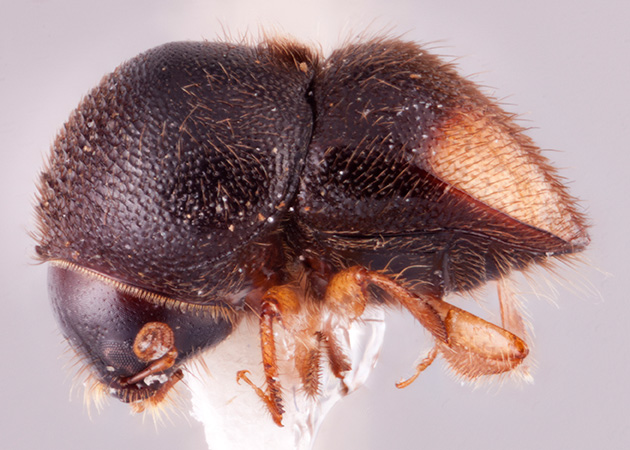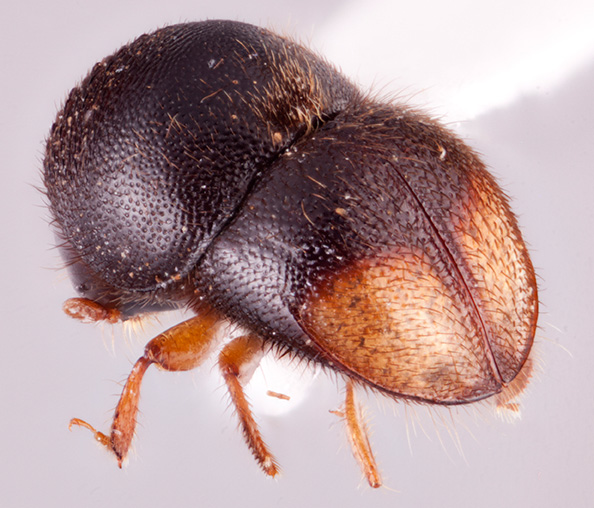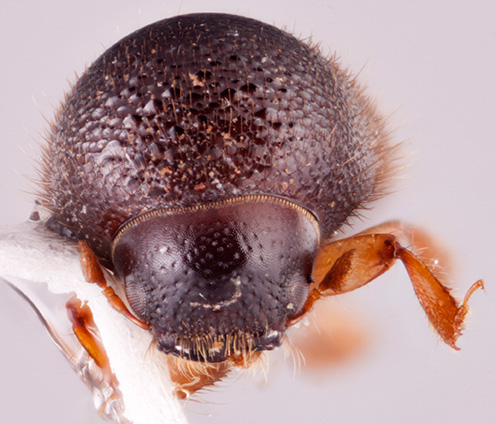Cnestus improcerus
|
Cnestus improcerus lateral; R.K. Osborn |
|
Cnestus improcerus dorsal; R.K. Osborn |
|
Cnestus improcerus declivity; R.K. Osborn |
|
Cnestus improcerus frontal; R.K. Osborn |
Taxonomic history
Xyleborus improcerus Sampson, 1921: 33.
Xylosandrus improcerus (Sampson): Beaver, 1998: 183.
Cnestus improcerus (Sampson): Dole and Cognato, 2010: 529.
Diagnosis
2.7−3.3 mm long (mean = 3.04 mm; n = 5); 1.67−1.74 times as long as wide. This species can be distinguished by the presence of a mesonotal mycangial tuftmycangial tuft:
tuft of setae that denotes the mycangia exterior opening
 on the pronotalpronotal:
on the pronotalpronotal:
pertaining to the pronotum
basebase:
point or edge closest to the body; opposite of apex ; elytralelytral:
; elytralelytral:
pertaining to the elytra
discdisc:
the flat central upper surface of any body part (e.g. pronotum and elytra) very short; procoxae widely separated; elytralelytral:
very short; procoxae widely separated; elytralelytral:
pertaining to the elytra
declivitydeclivity:
downward slope of either the pronotum or elytra
 bicolored, with the basalbase:
bicolored, with the basalbase:
point or edge closest to the body; opposite of apex half black and the apicalapex:
half black and the apicalapex:
point or edge furthest from the body; opposite of base
 half with a pale translucent area; declivitydeclivity:
half with a pale translucent area; declivitydeclivity:
downward slope of either the pronotum or elytra
 flat; pronotumpronotum:
flat; pronotumpronotum:
the dorsal surface of the thorax
type 1 when viewed dorsally; antennalantennal:
pertaining to the antennae
club type 2, with two sutures visible on posteriorposterior:
toward the rear end; opposite of anterior
 face; antennalantennal:
face; antennalantennal:
pertaining to the antennae
funicle four-segmented; protibiaprotibia:
tibia of the first pair of legs
distinctly triangular; posterolateralposterolateral:
relating to end of the side part/portion
 margin of elytraelytron:
margin of elytraelytron:
the two sclerotized forewings of beetles that protect and cover the flight wings
moderately carinate from apexapex:
point or edge furthest from the body; opposite of base
 to declivitaldeclivital:
to declivitaldeclivital:
pertaining to the elytral declivity
basebase:
point or edge closest to the body; opposite of apex along interstriaeinterstria:
along interstriaeinterstria:
longitudinal spaces along the elytra between the striae, which is not as<br />
impressed and bear smaller punctures.
 7; interstriaeinterstria:
7; interstriaeinterstria:
longitudinal spaces along the elytra between the striae, which is not as<br />
impressed and bear smaller punctures.
 punctate, setose, and ground vestitureground vestiture:
punctate, setose, and ground vestitureground vestiture:
minute recumbent vestiture
absent.
May be confused with
Xylosandrus spp., Cnestus gravidus, C. mutilatus, and C. testudo
Distribution
‘Borneo’, Brunei, East & West Malaysia, Thailand
Host plants
recorded from Canarium (Burseraceae), Dipterocarpus (Dipterocarpaceae), and an unidentified genus of Lauraceae (Browne 1961bBrowne 1961b:
Browne FG. 1961b. The biology of Malayan Scolytidae and Platypodidae. Malayan Forest Records 22: 1-255.)
Remarks
Reported by Wood and Bright (1992) as occurring in India but no actual records have been found.
DNA data
Sequences available for COI and CAD.
COI: GU808715
CAD: GU808636





